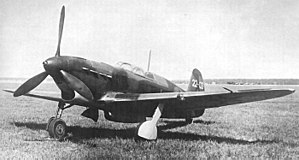Yakovlev Yak-7
| Yak-7 (UTI-26) | |
|---|---|
 |
|
| Role | Fighter, trainer - In the picture, Yak-7B/M-105PA serial N°23-03 (3rd production batch, 22nd aircraft) during its trials at the NII VVS. |
| Manufacturer | Yakovlev |
| Designer | Alexander Sergeevich Yakovlev |
| First flight | 23 July 1940 |
| Introduction | 1942 |
| Status | Retired |
| Primary user | Soviet Air Force |
| Produced | 6,399 |
| Developed from | Yak-1 |
The Soviet Yakovlev Yak-7 was developed from the earlier Yak-1 fighter, initially as a trainer but converted into a fighter. As both a fighter and later reverting to its original training role, the Yak-7 proved to be a capable aircraft and was well liked by air crews. The Yak-7 was simpler, tougher and generally better than the Yak-1.
In 1939, Alexander Yakovlev designed a tandem-seat advanced trainer, originally designated "I-27" and then "UTI-26", offered along with the original I-26 proposal that became the Yak-1. The "UTI" (Uchebno Trenirovochnyi Istrebitel, translated as: Training Fighter) was intended to give pilots-in-training experience on a high-performance aircraft before transitioning to a fighter. With development work started in 1940, the UTI-26 differed from its predecessor in its larger span wing being placed farther back for balance as well as having two cockpits with dual controls and a rudimentary communication system. It was armed with a single 7.62 mm (0.30 in) ShKAS machine gun in the cowling, mainly for use in training, but Yakovlev envisioned a multi-purpose aircraft that could also undertake courier and light transport duties at the front.
The first production aircraft known as Yak-7UTIs retained a retractable main landing gear, but beginning in the summer of 1941, a fixed landing gear variant, the Yak-7V (Vyvozoni for Familiarization) was substituted. The factory reasoned that production would be simplified and that reduced performance would not be detrimental for a trainer. Yak-7UTIs and Yak-7Vs were also equipped with skis for winter operations.
A factory team from N° 301, headed by K.A. Sinelshchikov, was detached from the Yakovlev OKB to supervise production of Yak-7UTI. One of these aircraft (serial number 04-11) was fitted with an armored backrest plate over the rear position, self-sealing fuel tanks which filled with inert gas as they emptied, three "RO" rocket launchers under each wing for as many RS-82 rockets, an axial motornaya pushka-mount 20 mm (0.79 in) ShVAK cannon firing through the propeller spinner, with 120 rounds, and two 7.62 mm ShKAS machine guns under the cowling, each with 750 rounds. The rear cockpit position was retained, allowing it to accommodate a second seat (without controls) for fast courier and transport duties or a fuel tank for extended range. The additional space could also house bombs or other gear. The engine was an M-105P and the model was designated Yak-7/M-105P.
...
Wikipedia
